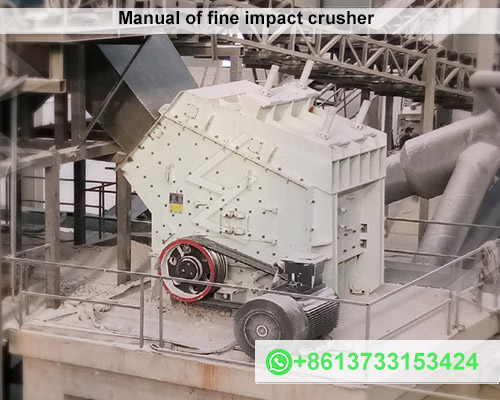Manual of fine impact crusher
A fine impact crusher is an essential piece of equipment in the construction and mining industries, where it is used to crush materials into fine particles. Unlike traditional crushers, which are designed for coarse crushing, fine impact crushers focus on producing a finer product with better particle shape and size distribution. This manual provides an overview of the working principles, features, maintenance practices, and safety guidelines associated with fine impact crushers.

Working Principle
Fine impact crushers operate on the principle of impact crushing, where materials are broken down by the high-speed impact of a hammer or blow bar. The material is fed into the crusher, where it encounters rotating hammers or bars attached to a rotor. As the rotor spins, the hammers strike the material, causing it to shatter. The crushed material is then forced through a set of sieves or grates that control the final particle size.
Key Components
- Rotor: The heart of the fine impact crusher, the rotor is equipped with hammers or blow bars that rotate at high speeds to deliver powerful impacts on the material.
- Hammers/Blow Bars: These are the primary tools that make contact with the material, breaking it down into smaller pieces. Made of high-strength steel or other durable materials, they are designed to withstand the wear and tear of constant use.
- Grate/Sieve: Positioned below the rotor, the grate or sieve controls the size of the output material by allowing only particles smaller than the specified size to pass through.
- Housing: The outer casing that encloses the entire crusher mechanism, protecting it from dust and debris while also reducing noise and vibration.
- Feeder: This component ensures the steady and controlled flow of material into the crusher, preventing overloads and ensuring uniform crushing.
Features and Advantages
- High Efficiency: Fine impact crushers are designed to achieve high reduction ratios, converting large feed sizes into fine particles with minimal energy consumption.
- Uniform Particle Size: The use of grates or sieves ensures that the output material has a consistent and uniform size, making it suitable for various applications.
- Versatility: These crushers can handle a wide range of materials, including limestone, coal, gypsum, and more, making them ideal for use in different industries.
- Adjustable Output: By changing the grate or sieve, operators can adjust the final particle size to meet specific requirements.
Maintenance and Care
Proper maintenance is crucial to ensure the long-term performance and efficiency of a fine impact crusher. Here are some key maintenance practices:
- Regular Inspection: Regularly inspect the hammers, blow bars, rotor, and grates for signs of wear and tear. Replace worn-out components to maintain optimal performance.
- Lubrication: Ensure that all moving parts are adequately lubricated to reduce friction and prevent overheating.
- Cleanliness: Keep the crusher clean by removing any accumulated dust, debris, or material build-up. This helps prevent blockages and reduces wear on components.
- Alignment: Regularly check the alignment of the rotor and other critical components to avoid vibrations and ensure smooth operation.
- Safety Checks: Ensure that all safety features, such as emergency stop buttons and guards, are functioning correctly.
Safety Guidelines
Operating a fine impact crusher requires strict adherence to safety protocols to prevent accidents and injuries. Here are some safety guidelines to follow:
- Personal Protective Equipment (PPE): Always wear appropriate PPE, including safety goggles, gloves, ear protection, and steel-toed boots.
- Training: Only trained and authorized personnel should operate the crusher. Ensure all operators are familiar with the machine’s controls and emergency procedures.
- Lockout/Tagout: Before performing any maintenance or repairs, follow the lockout/tagout procedure to ensure the machine is completely de-energized.
- Clear Work Area: Keep the area around the crusher clean and free of obstacles to prevent trips and falls.
- Monitor for Hazards: Be vigilant for any signs of malfunction, such as unusual noises, vibrations, or excessive dust. Address issues immediately to prevent accidents.
Fine impact crushers are vital in producing high-quality, fine-grained materials for various industries. By understanding their working principles, maintaining them properly, and adhering to safety guidelines, operators can ensure that these machines function efficiently and safely. This manual serves as a comprehensive guide to the operation, maintenance, and safety of fine impact crushers, helping users maximize their productivity and minimize downtime.









